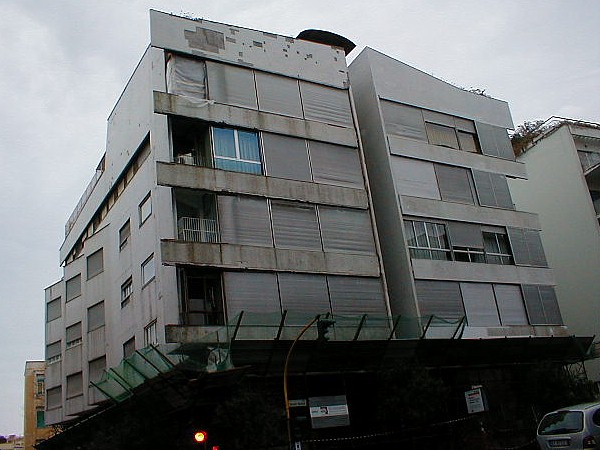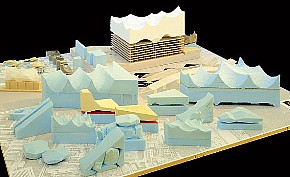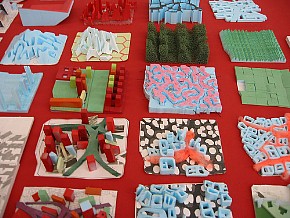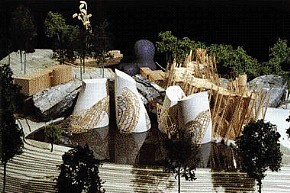2007.12.01 08:31
Consumerism and Monumentality
canon : the body of rules, principles, or standards accepted as axiomatic and universally binding in a field of study or art
axiom : a self-evident truth that requires no proof
That memory, whether it be lucid or vague, functions primarily as a reenactment is axiomatic.
The operative word/notion within the definiton of canon is "accepted," which adds substantial subjectivity. Thus canons, in and of themselves, are not axiomatic.
Canons emerge via power play.
power play : an action, stratagem, or maneuver, as in politics or business, by which power is concentrated or manipulated in order to subdue a rival or gain control of a situation.
That canons emerge via power play may well be axiomatic.
Is it axiomatic then too that novel canons emerge via novel power plays?
[Did you just read a novel axiom?]
2008.05.29 09:27
Can you say canonical?
"...you might like to know that Ten Canonical Buildings: 1950-2000 will be released on June 24, 2008.
Peter Eisenman, renowned for his own controversial and influential body of work, looks at ten leading architects of the twentieth century and their theoretical positions, technological innovations, and design contributions. Eisenman identifies a project within the oeuvre of each of these architects—Luigi Moretti, Ludwig Mies van der Rohe, Le Corbusier, Louis Kahn, Robert Venturi, James Stirling, Aldo Rossi, Rem Koolhaas, Daniel Libeskind, and Frank Gehry—that has profoundly affected architectural discourse and practice. With drawings, diagrams, and always-incisive text, he presents each architect's theoretical position, and then offers detailed critical analysis of the project."
Any guess what the 10 buildings might be? Your own picks?
Moretti: Casa del Girasole (Eisenman)
Mies: Seagrams (Eisenman)
Le Corbusier: Palais des Congrès (me)
Le Corbusier: Olivetti Center Milan (me)
Kahn: Dominican Sisters Convent (me)
Venturi & Rauch: Franklin Court (me)
Stirling: Leicester Engineering (Eisenman, "Real and English")
Stirling: Nordrhein/Westfalen Museum (me)
Stirling: Wallraf-Richartz Museum (me)
Rossi: Modena Cemetery (Eisenman)
Koolhaas: Patent Office (me)
Libeskind: who cares (me)
Gehry: Wagner Residence and other residences of that era (me, just to be a bit obscure)
2008.05.29 10:42
Can you say canonical?
'Canonical' is a tricky adjective itself. One definition of canon is 'a list of saints' as in a list of those individual deemed to be safely in heaven. In a (typical?) way, Eisenman is trying to be the establisher of an architectural canon.
Luckily, Peter was the first Pope, and no subsequent pope has ever taken the name of Peter.
Is 'canonical diversity' an oxymoron?
2008.05.30 09:17
Can you say canonical?
"In the Casa del Girasole itself, materiality replaces abstraction. The materials do not stand for anything; they are. At the same time, there is no dominant material system that suggests a preference for one material over another. Neither is there a color palette that makes any kind of structural or formal sense; the colors merely exist. This is a form of neorealism in architecture"
Peter Eisenman, "Critical Analysis: Luigi Moretti" in Peter Eisenman: Feints, (2006), p. 67.
But the real point will be:
Luigi Moretti, "The Value of Profiles", 1951.
Luigi Moretti, "Structures and Sequence of Spaces", 1952.
both reprinted in Oppositions 4, (1975).
I'm beginning to smell a bit of a 1970s reenactment...
"I remember Rosiland Krauss telling me "You with your surrealist shit", when she heard the word [delirious] in the seventies. It seemed the most efficient terminology to introduce at the time, even though the time was definitely hostile to it."
Rem Koolhaas (2006).
I think I'm telepathic because I often hear "You with your reenactment shit".
"Luigi Moretti's apartments on the Via Parioli in Rome: are they one building with a split or two buildings joined?"
Robert Venturi, "Ambiguity" in Complexity and Contradiction in Architecture. (1966).
The Church of Peter and Latter-Day Canonicals: is that multiple buildings joined or one building splintered?

| |
2008.06.01 11:07
Can you say canonical?
"In this painstaking analysis of an apparent architectural syntax, the author offers a fresh interpretation of one of the canonical works of the Brutalist movement--the Stirling and Gowan Leicester Engineering Building, completed in 1963. Responding independently to one aspect of a theme broached by Manfredo Tafuri in Oppositions 3, Eisenman attempts to uncover the precise manner in which Stirling has rewritten the "words" of modern architecture."
--Kenneth Frampton, an introduction to "Real and English: The Destruction of the Box. I." (1974).
The article was first presented in lecture form at Cooper Union in the spring of 1973 and again at Yale during the spring of 1974.
"The thrust of the argument below will be that the Leicester Engineering Building invokes a similar critical and thus, polemical, intention as Venturi, but does so in a different and perhaps less traditional manner--by distorting the form of the iconic structure as opposed to perverting the form of the iconic content, as in the case with Venturi."
"Much of the work of Louis Kahn, which proposes a classical alternative to a modern eclecticism, can surely be seen..."
"...and more recently in the wall decompositions of John Hejduk, destroys it conceptually."
"Real and English: The Destruction of the Box. I" was a (personal) inspirational motivator for a fourth year design (taken through to working drawings) project, Fall 1979. None of the faculty "got" the design--it was like Leicester Engineering meets Staatsgalerie Stuttgart. Hyper Avant. Very distorted iconic structure fucks with perverted iconic content. Then during "working drawings", Spring 1980, witnessed schizophrenic survival of horrific expressway accident, emergency room lobotomy, subsequent two-week drug-inducted coma, and the commencement of a whole new history (where all that remains canonical is a sense of humor).
2008.06.25 14:23
Can you say canonical?
"Eisenman's Canon..."
Luigi Moretti, Casa "Il Girasole," 1947-50
Lugwig Mies van der Rohe, Farnsworth House, 1946-51
Le Corbusier, Palais des Congrès-Strasbourg, 1962-64
Louis I. Kahn, Adler & DeVore Houses, 1954-55
Robert Venturi, Vanna Venturi House, 1959-64
James Stirling, Leicester Engineering Building, 1959-63
Aldo Rossi, Cemetery of San Cataldo, 1971-78
Rem Koolhaas, Jussieu Libraries, 1992-93
Daniel Libeskind, Jewish Museum, 1989-1999
Frank O. Gehry, Peter B. Lewis Building, 1997-2002
2008.06.25 20:31
Can you say canonical?
Just wait till you read the first few sentences on page 129. Apparently the book is interchangably tragic and comedic.
2008.06.26 08:05
Can you say canonical?
Odd dyslexical, editorial mistakes on pages 88 and 89 (etc.):
On page 88, the fifth floor is depicted, yet it is labeled and analyzed as if it were the fourth floor.
Likewise, on page 89, the fourth floor is depicted, yet it is labeled and analyzed as if it were the fifth floor.
The mistake is carried through on page 91 where "...the fulcrum for the spiraling movement in the second, third and fourth floors." should actually read "second, third and fifth floors."
Additionally, what is 'interpreted' as a central stair core of the building, is actually a stacked pair of up and down escalators. The stair "core" of the building is someplace else.
And it is unfortunate that the stage set is missed altogether within the 'canonical' analysis, as it would have offered the 'missing link' of clarity to the whole figure/grid development.
Hejduk, wo bist du?
In the Introduction, Eisenman emphasizes the notion of "close reading", yet, with the series of mistakes within (at least) the Palais des Congrès analysis, I have to wonder just how closely Eisenman actually "read" these buildings and how much was simply relied upon the student analyses that the book is based on.
| |
2008.06.28 08:47
Can you say canonical?
"...does there have to be ten buildings?"
A close reading of Ten Canonical Buildings: 1950-2000 very much discloses a sublimated implicit nth canonical building, videlicet Quondam, a virtual museum of architecture: 1996-.
The stars of Ten Canonical Buildings: 1950-2000, somewhat ironically, are not actual buildings at all, viz. the Palais des Congrès-Strasbourg (1962-64) and the Jessieu Libraries (1992-93). In the Forward, Stan Allen refers to the Palais des Congrès as a "previously somewhat overlooked building." As it happened, Arcadia's 1991 published analysis of the Palais des Congrès became one of the corner stones of Quondam. Was Koolhaas aware of Arcadia's analysis within the Loeb Library at Harvard?
In a geometrically progressive sense, Eisenman describes canonical buildings as designs which themselves manifest a close reading. Albeit requiring a 'photo-finish', Stirling wins the "architect as close reader" award, with many close seconds. Stirling perfected the reenactionary architecturism kick.
While reading/skimming through Ten Canonical Buildings: 1950-2000, I often wish Koolhaas was the author rather than Eisenman (although Eisenman does indeed set a fine stage himself), but, alas, Koolhaas has already designed another nth canonical building, viz. OMA's Patent Office:
"Social Condenser" (1982)
"Strategy of the Void I" (Planning) (1987)
"Timed Erasures" (1991)
"Loop-Trick" (1987)
"Strategy of the Void II" (Building) (1989)
"Stacked Freedoms" (1989)
"Inside-Out City" (1993)
"Disconnect" (1994)
"Everywhere and Nowhere" (1994)
"Variable Speed Museum" (1995)
"Inertness Modified" (1997)
Tall & Slender (1996)
Skyscraper Loop (2002)
"Cake-tin Architecture" (2002)
"The End of the Road" (2003)
2008.06.30 15:58
Can you say canonical?
Close reading really shouldn't manifest intellectual property issues.
"We understand Le Corbusier's Palais des Congrès in Strasbourg as canonical today primarily because it has sponsored several generations of work on the warped surface. In this case, Koolhaas's Jussieu Libraries confer a retrospective "canonical" status to this previously somewhat overlooked building."
--Stan Allen, 2008
Quondam, 2000.05.06
2008.07.05 10:27
Can you say canonical?
...read the 'Introduction' and be aware of Eisenman's ongoing oppositional reenactment of Colin Rowe's analytical method (which ultimately reaches farce in the analysis of the 10th canonical building).
One could almost describe Eisenman's whole architectural design career as one oppositional reenactment after another, finally puctuated with bursts of intense originality (like the Max Reinhardt Haus, Haus Immendorf and the Staten Island Institute of Arts and Sciences).
| |
2008.08.23 15:16
Peter's canon
One thing that crossed my mind last night was how, when I see the many study models of H&dM...

...and OMA...

...I'm reminded of the many study models produced by Gehry for the Lewis Residence...

(I may be stretching it, but...)
Gehry's method of design via innumerable study models seems to have become quite influential.
2008.08.31 11:03
Can you say canonical?
"Take a look at Le Corbusier's Palais des Congres a Strasbourg (1964), and then look at OMA's Hotel at Agadir, the Library at Jussieu, the Educatorium, and then MVRDV's VPRO--a trail of design reenactments."
2004.09.23 12:14
cf. 2008.06.30 12:58 above
|